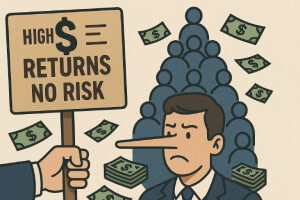Regulation of Crypto & Market Challenges: How to Avoid Scams
The emergence of cryptocurrenies has brought forth massive opportunities but with those opportunities lie great challenges in the industry. Market volatility, had scams, government regulations, and future mass adoption are just some of the challenges facing this Industry. Those very challenges are viewed below and their possible effects on the crypto space.
Market Volatility and Speculative Risks
The crypto market is notoriously volatile, with prices often swinging wildly within short timeframes. These attest to the presence of opportunities for quick profits and expose investors to huge risks. Price fluctuations emanate chiefly from speculative trading based on trends and news, not on actual value. Investors should be aware of the risks involved and know that the market is unpredictable, as gains surely can metamorphose into losses.
Scams, Rug Pulls, and How to Avoid Them
Hundreds of scams run in the crypto world, right from Ponzi schemes to rug pulls. In the latter, projects stop operations after cashing investors' investment. Such scams are more frequent in the DeFi and NFT markets. To ensure that you do not become victim the next time, always conduct due diligence of a project, check the credentials of the team members, and do not fall for any unreasonably good promises. Use only reputable platforms and be very cautious about investing in any new or unknown project.

Ponzi Schemes and Fake Promises
Ponzi schemes, by definition, promise high fixed returns and claim little or no risk. The money of new investors is used to pay older investors, so practically no revenue is ever generated. Be wary of any project offering returns that are too good to be true-these returns are almost certainly false. Always research thoroughly before investing in any project.

Rug Pulls: Sudden Disappearances
In a rug pull, a project or token sells its offering to investors with an exit-the-gate mentality getting away with their goods by vanishing overnight, and what they got were worthless assets. These scams flourished in the added iteration of DeFi and NFT realms, whose liquidity pools are largely shallow and whose teams lack prominent information. Before engaging in another new project, check it for transparency, a verifiable team, and a clear roadmap.

How to Protect Yourself
Research before becoming tightly caught in scams. Do some research and approach the whitepaper, background of the members in the team, any audit, or third-party assessment. Exchange only at reputed exchanges or platforms having a genuine history and be careful about unknown/very new projects asked from you. Rushing into an investment is a big detriment—take your time and assess the risks.Regulation and Governments’ Response to Crypto
Regulations for cryptocurrencies have been universal among governments and have been implemented either too late or inconsistently. Some countries have taken the very progressive stance of legalizing it, while others have gone to the lengths of banning it altogether for any crypto-related activity (e.g., China). In the United States, regulatory agencies like the SEC try to classify what cryptocurrencies are and which rules should apply to them, whereas Europe now looks at unifying regulation under MiCA. It is crucial for the balance of innovation with proper oversight to be attained for the future of this marketplace.
Positive Adoption: El Salvador's Bitcoin Move
In 2021, El Salvador made history as the first country to adopt Bitcoin as a legal currency. The groundbreaking decision was taken with an eye toward promoting financial inclusion and attracting crypto investments. While the event is significant in terms of endorsing the promise of crypto, it has since set the debate on long-term stability and the risks of using a cryptocurrency as a national currency.
A General Prohibition: China's Crypto Ban
On the other hand, the government of China has cracked down on crypto activities. Crypto exchanges, crypto mining, and ICOs are all banned in China. The reasons behind the issue may lie in the country's concerns over maintaining financial stability, combating fraud, and trying to channel digital currency innovations and developments into its own Central Bank Digital Currency (CBDC).
The Regulatory Environment in the United States
Regulatory bodies such as the Securities and Exchange Commission (SEC) and the Commodity Futures Trading Commission (CFTC) are working toward the establishment of a legal and regulatory framework for cryptocurrencies. However, because the categorization of cryptocurrencies as securities or commodities is still hazy, it causes uncertainty amongst businesses and investors. With time, U.S. regulations are evolving, hence the hopes of some for clearer rules that will create stability and enable growth.
Mass Adoption, CBDCs, and Sustainability Concerns

Concerning the future, mass adoption of cryptocurrencies really puts forth the main goal; solving scalability and usability issues is required first. Central Bank Digital Currencies (CBDCs) are gradually coming into existence as government-backed alternatives with the view of being a more stable digital currency. In opposition to the basic decentralized nature of crypto, their mere existence challenges that principle. Sustainability is likewise a concern, given that the process of mining crypto wastes a lot of energy. There are some solutions-in-transition-i.e., Ethereum going to proof-of-stake-but the debate regarding the system's environmental impact continues.
Turning Challenges into Opportunities
Among the challenges confronting the cryptocurrency market, recent ones include volatility, speculation, scams, and regulatory hurdles. While runoff and bad weather may damage the flower, they also provide the conditions necessary for its growth and blossoming. With maturity-dating-longer into it, balancing regulation with sustainability and adoption will be important to its bard.